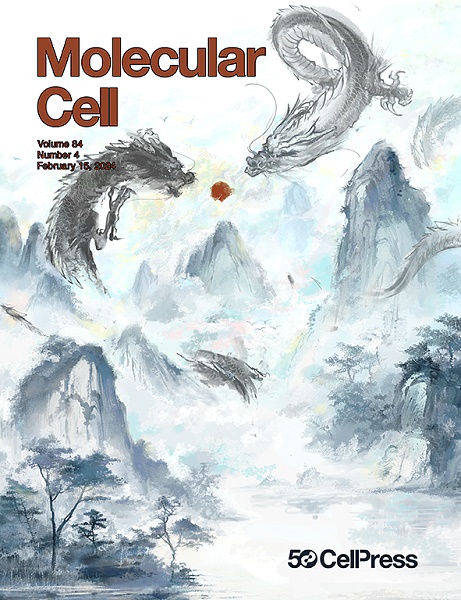PARP 酶从头合成不含蛋白质的聚(ADP-核糖)
IF 14.5
1区 生物学
Q1 BIOCHEMISTRY & MOLECULAR BIOLOGY
引用次数: 0
摘要
PARP 酶将 NAD+ 中的 ADP 核糖转移到蛋白质上,作为一种共价修饰,调节着细胞生物学的多个方面。在这里,我们发现了人类 PARP1 的一种未被发现的催化活性:从头生成未附着在蛋白质上的游离 PAR 分子。当一个 NAD+ 分子或 ADP-ribose 分子与 PARP1 受体位点对接,并与结合在供体位点的 NAD+ 分子结合,释放出烟酰胺并启动由 NAD+/ADP-ribose 而不是蛋白质产生的 ADP-ribose 链时,就会产生游离 PAR。人类 PARP2 和 PARP 酶 Tankyrase 也会产生游离 PAR。我们证明,细胞中的游离 PAR 主要是由 PARP1 从头合成活性产生的,而不是由 PAR 糖水解酶(PARG)、ARH3 和 TARG1 从蛋白质中释放 PAR 而产生的。游离 PAR 和蛋白质连接修饰的同时产生改变了 PAR 信号转导的模型,扩大了 PARP 酶信号转导能力的范围。本文章由计算机程序翻译,如有差异,请以英文原文为准。

PARP enzyme de novo synthesis of protein-free poly(ADP-ribose)
PARP enzymes transfer ADP-ribose from NAD+ onto proteins as a covalent modification that regulates multiple aspects of cell biology. Here, we identify an undiscovered catalytic activity for human PARP1: de novo generation of free PAR molecules that are not attached to proteins. Free PAR production arises when a molecule of NAD+ or ADP-ribose docks in the PARP1 acceptor site and attaches to an NAD+ molecule bound to the donor site, releasing nicotinamide and initiating ADP-ribose chains that emanate from NAD+/ADP-ribose rather than protein. Free PAR is also produced by human PARP2 and the PARP enzyme Tankyrase. We demonstrate that free PAR in cells is generated mostly by PARP1 de novo synthesis activity rather than by PAR-degrading enzymes PAR glycohydrolase (PARG), ARH3, and TARG1 releasing PAR from protein. The coincident production of free PAR and protein-linked modifications alters models for PAR signaling and broadens the scope of PARP enzyme signaling capacity.
求助全文
通过发布文献求助,成功后即可免费获取论文全文。
去求助
来源期刊

Molecular Cell
生物-生化与分子生物学
CiteScore
26.00
自引率
3.80%
发文量
389
审稿时长
1 months
期刊介绍:
Molecular Cell is a companion to Cell, the leading journal of biology and the highest-impact journal in the world. Launched in December 1997 and published monthly. Molecular Cell is dedicated to publishing cutting-edge research in molecular biology, focusing on fundamental cellular processes. The journal encompasses a wide range of topics, including DNA replication, recombination, and repair; Chromatin biology and genome organization; Transcription; RNA processing and decay; Non-coding RNA function; Translation; Protein folding, modification, and quality control; Signal transduction pathways; Cell cycle and checkpoints; Cell death; Autophagy; Metabolism.
 求助内容:
求助内容: 应助结果提醒方式:
应助结果提醒方式:


